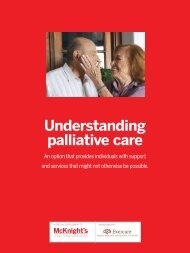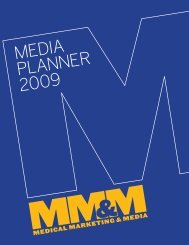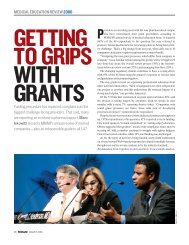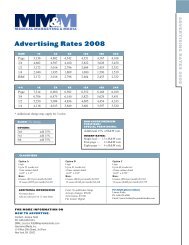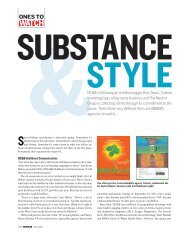Review - Haymarket Media Group
Review - Haymarket Media Group
Review - Haymarket Media Group
Create successful ePaper yourself
Turn your PDF publications into a flip-book with our unique Google optimized e-Paper software.
<strong>Review</strong><br />
ma and/or peau d’orange, and biopsy-confirmed<br />
invasive carcinoma with or without evidence of<br />
dermal lymphatic invasion. Tumors were classified<br />
as HER2 positive if they exhibited 3+ staining by<br />
immunohistochemistry (IHC) and/or gene amplification<br />
by fluorescence in situ hybridization (FISH)<br />
technique. Tumors were classified as HER2 negative<br />
if they exhibited 1+ or negative staining by<br />
HER2 is amplified<br />
in approximately<br />
30% of breast tumors.<br />
IHC and/or no gene amplification by FISH. All<br />
patients received adjuvant anthracycline-based<br />
chemotherapy regimens followed by a mastectomy,<br />
comprehensive radiation therapy to chest wall and<br />
axilla, and adjuvant hormonal therapy when appropriate.<br />
Patients with HER2-positive tumors did not<br />
receive adjuvant trastuzumab as the monoclonal<br />
antibody had not received approval for use in the<br />
Unadjusted estimates*<br />
18 The American Journal of Hematology/Oncology<br />
adjuvant setting at the time of diagnosis. Upon<br />
recurrence, patients with HER2-positive tumors<br />
were allowed to have received trastuzumab.<br />
Recurrence-free survival (RFS), defined from the<br />
date of diagnosis to the date of local or distant<br />
recurrence or last follow-up, and overall survival<br />
(OS), defined from the date of diagnosis to death<br />
from any cause or last follow-up, was computed.<br />
The Kaplan-Meier product limit method was used<br />
to determine 5-year survival estimates, which were<br />
compared across groups using log-rank statistics.<br />
Cox proportional hazards models were then fitted<br />
to determine the association of HER2 status to survival<br />
outcomes after adjusting for patient and<br />
tumor characteristics.<br />
Of the 179 patients, 111 (62%) had HER2-negative<br />
disease and 68 (38%) had HER2-positive disease.<br />
<strong>Media</strong>n age for the cohort was 51 years (range, 28-78<br />
years), and median follow-up among all patients still<br />
alive at last follow-up was 41 months (range, 3-198<br />
months). At the time of the analysis a total of 104<br />
patients had recurred; 62 of 111 (55.9%) with HER2negative<br />
disease and 42 of 68 (61.8%) with HER2positive<br />
disease. Of the 42 patients with HER2-positive<br />
disease who recurred, 31 (73.8%) received<br />
trastuzumab in the metastatic setting. The Table<br />
summarizes the unadjusted and adjusted RFS and<br />
OS estimates. Overall Kaplan-Meier estimates for 5year<br />
RFS was 37.8% (95% CI, 29.9%-45.7%), and 5-<br />
Table<br />
Unadjusted and Adjusted 5-Year Recurrence-Free and Overall Survival Estimates<br />
Recurrence- Overall<br />
Free Survival P Value Survival P Value<br />
HER2 negative 38.8% 49.8%<br />
(28.7%-48.8%) (38.0%-60.6%)<br />
HER2 positive 36.5% 0.750 57.8% 0.245<br />
(24.0%-49.0%) (43.4%-69.8%)<br />
Adjusted estimates †<br />
HER2 0.75 0.241 0.56 0.024<br />
(positive vs negative) (0.46-1.22) (0.34-0.93)<br />
*These are Kaplan-Meier estimates that have been compared across groups using log-rank statistics.<br />
† These are adjusted hazard ratios. The models were adjusted for age (continuous), estrogen receptor status (positive vs negative),<br />
progesterone receptor status (positive vs negative), lymphovascular invasion (yes vs no), grade of tumor (3 vs 1 and 2), lymph node<br />
status (positive vs negative), and pathological complete response (yes vs no).



